Olivier Filippi
Filbert Press, February 2016

If you are like me, a typical amateur gardener originating from a temperate, oceanic region of north-west Europe, the first action you should take before plunging into Olivier Filippi’s English language translation of his Alternatives au Gazon is to purge from your mind the synonymous connection of the words ‘lawn’ and ‘grass’. Olivier notes that the words ‘lawn’ or ‘conventional lawn’ refer to modern lawns composed of rye-grass species, while the terms ‘mixed’ or ‘wild’ lawns designate areas which can include other annual or perennial species.
It is also easy to adopt the mind-set that the term ‘groundcover’ simply refers to any low growing, green perennial with a carpeting habit. In the book, the term is used to describe all plants, of whatever height, shape or type, which provide alternatives to a conventional lawn.
The initial part of the book covers the history and development of lawns and provides much background detail that even non-gardening readers will find informative. The generous bibliography quoted on this topic offers the reader the opportunity to delve deeper into its history.
In more recent times, the increasing attraction of the lawn as an adjunct to our homes has encouraged the providers of mechanical aids and agricultural chemicals to promote their products to a market eager to strive for visual perfection. This goal has become somewhat of a status symbol – the larger, smoother, more even and blemish free the lawn equating to how well off the owner is. Exposure of immaculate sports pitches, tennis courts and golf greens on television feeds the desire to emulate a similar appearance in our own gardens. This need, to be surrounded by a green environment, is reinforced by the deep rooted psychological needs for calmness, tranquillity and reduced stress. In some circumstances the lawn has become, if not a deity, at least an altar. Page 17 of Olivier’s book shows a photograph of the Park of Versailles in which a ‘green carpet’, created for Louis XIV, is surrounded by hundreds of visitors, none of whom can enjoy the sensation of walking on the grass. They are prevented from doing so by a low barrier. Even in less prestigious public areas it is still common to encounter the notice ‘Keep off the grass’.

It is often quoted that the upkeep of a lawn involves time and money, to this one can add the obsessive and excessive use of the numerous ….CIDES and fertilisers with a view to the creation of micro-monoculture spaces, accompanied by the inevitable environmental and ecological degradation.
If by now the reader, located in a hot dry climate zone, has begun to experience a feeling of – all right, what to do next – he should not despair. In his trade mark method of in-depth research, coupled with many years of practical experience in a Mediterranean climate, Olivier has provided the gardener in search of alternatives with a comprehensive tool kit, and no, a synthetic lawn is not the answer.
Olivier begins by describing types of groundcover plants, how they cope with the stresses of the local environment and how they contribute to our need for low watering and maintenance. For those gardeners who absolutely cannot manage without at least a token area of grass, the properties of warm season and cool season grasses are explained with the goal of making a rational choice for a particular end use.
If an alternative form of ‘grass’ i.e. a green carpet, is acceptable, and depending on the amount of foot traffic, numerous plants including many flowering types are suggested. Olivier goes on to describe a number of other situations from ‘steppes’, gravel gardens, terraces, paths, wild gardens and meadows. Literally, something for everyone.
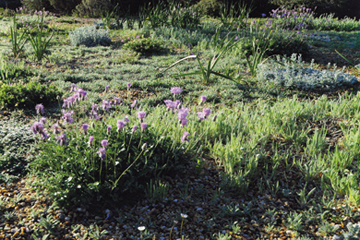
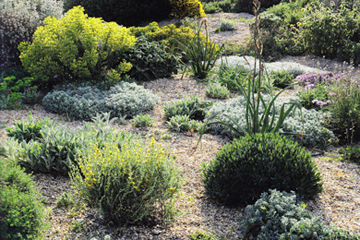
| ‘Steppe garden’ | Gravel garden |
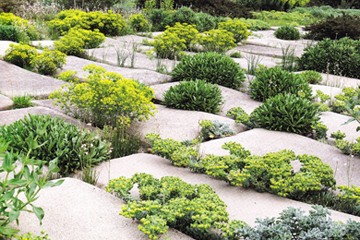
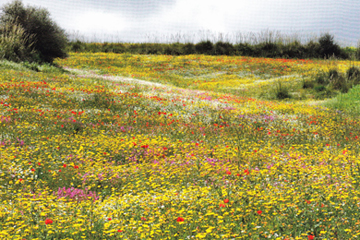
| Planted terrace | Meadow |
Beautiful, resilient groundcovers for terraces, paved areas, gravel and other alternatives to the lawn – excellent, thorough and inspirational.
Having dealt with the factors to be considered when planning a lawn formed of an alternative ground cover, the next section of the book gets down to the hard work of planting and maintenance. Techniques for coping with different types of soil, the need to enable oxygen access to the root system, and the importance of mycorrhizal fungi, are all explained, as are planting densities for different situations and the need for shallow basins to facilitate water needs over the first two years, illustrated by some excellent ‘how to’ photographs. Zoning of plants possessing similar water requirements and methods of applying water are detailed. The hazards of applying too much water, at the wrong time and place, leading to plant loss through Phytophthora are explained together with a number of techniques which can be employed to avoid this problem.
In order to deal with pests, a holistic approach would seem to be the direction to go, avoiding the conditions that favour the development of unwanted intruders, while promoting environments that allow beneficial predator species to multiply. These conditions are often achieved by including plants frequently considered as weeds, detailed on p.153, but which serve as food sources for the good guys. For readers concerned about the invasive potential of certain species Olivier outlines an analytical protocol for their assessment and tabulates examples of plants to avoid, or to exercise caution in their selection, for use as candidates for ground cover.
Overall, a thoroughly researched and thoughtful work packed with explanative details, comprehensive plant lists and illustrated throughout with over 400 stunning photographs.
Review by Alec Cobb – Mediterranean Gardening France
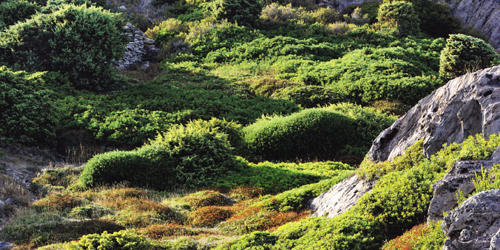
Beautiful, resilient groundcovers for terraces, paved areas, gravel and other alternatives to the lawn – excellent, thorough and inspirational.
In his second masterwork on dry gardens, pioneering nurseryman Olivier Filippi from south west France proposes a selection of low-maintenance groundcover plantings that are so beautiful they might just consign lawns to history. At last, the English edition of the 2011 Alternatives au Gazon, just as good, with the same ravishing photos and great advice and planting lists for various situations in the dry garden. The quality of this book puts it head and shoulders above any other offering advice on the subject of lawn removal and alternative planting. Specific recommendations give confidence to those seeking inspiration to get rid of their lawn and enter the wonderful world of appropriate gardening – with the added benefits of less maintenance and less cost. The photos and plant lists show the thorough research and scientific approach of the author, giving that rare combination of inspiration together with hard information.
The book is divided into four sections: groundcovers for managing space in gardens and public areas, various lawn alternatives tested by Filippi, practical aspects of creating a ground cover garden and finally an A to Z of recommended plants. There are also some useful notes on evaluating invasive ground cover plants.
Topics covered in detail include the creation of green carpets than can be walked on for high traffic areas, low level aromatic plants and bulbs for those areas less frequented and ground cover perennials and shrubs for larger areas. Gravel gardens, pavements and threshing floors can also be planted in order to provide colour and year round interest. Filippi encourages us to think of our gardens in zones, depending on how we use them, and shows us how to eliminate irrigation and reduce costs without compromising on beauty. Each zone is discussed, illustrated and has specific plant list recommendations.
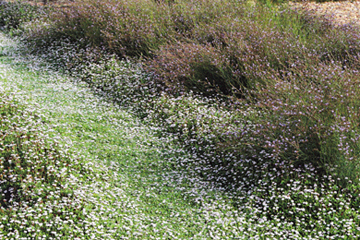
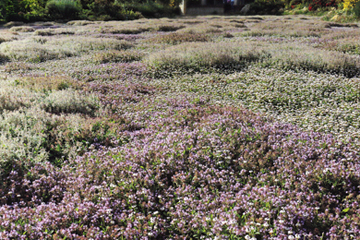
| Phyla nodiflora var. canescens is suitable for high traffic areas | Thymus hirsutus, Thymus ciliatus and Phyla nodiflora var. canescens forming a mixed carpet |
Review by Rosie Peddle – Mediterranean Gardening Association Portugal
